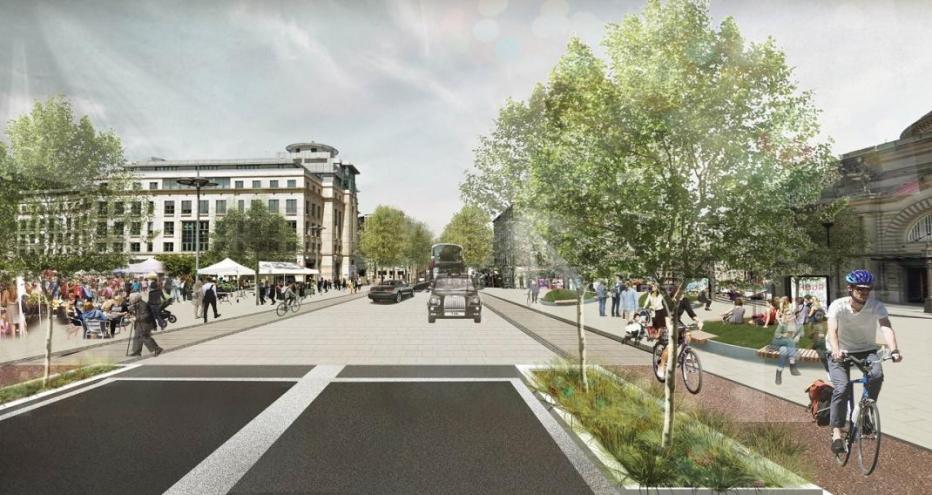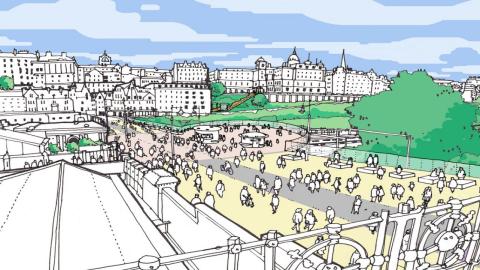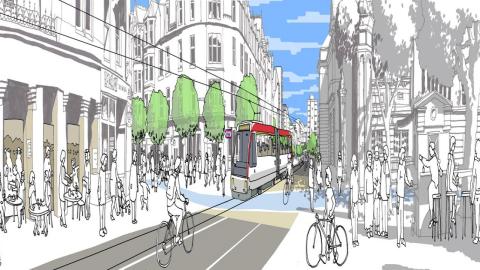



Jacobs. A world where you can.



As climate change threatens water security around the world, more communities are turning to water reuse as a resilient water supply solution and embracing the OneWater principle that all water has value. Jacobs has been supporting clients with water reuse programs for decades, beginning with the first applications of advanced wastewater treatment technologies in the 1960s. We provide our clients with a full range of services, from water reuse feasibility studies to design, construction and operations.



We’ve provided design-build services to the water sector for over 25 years and delivered more than 150 projects. We offer fully integrated design-build and design-build-operate capabilities to tackle the most complex water challenges and work in close collaboration with our clients.



For more than 30 years, Jacobs has been responsible for planning and implementing Lead and Copper Rule-related strategies which protect millions of people in the U.S. and Canada. Our work includes enhanced water quality monitoring strategies, sampling plan development, harvested pipe-scale analysis, lead service line inventories and replacement plans, corrosion control studies and the incorporation of equity and environmental justice considerations into compliance programs.



A curated selection of some of the top-listened to and trending podcast episodes from our popular If/When podcast series.



As a purpose-led company, we know we have a pivotal role to play in addressing the climate emergency. We consider this not only good business, but our duty to channel our technology-enabled expertise and capabilities toward benefitting people and the planet.



We work in partnership, delivering some of the most challenging, diverse and innovative projects and programs globally across multiple sectors. We integrate complex interfaces across planning, procurement and delivery to help unlock better social, environmental and economic outcomes from mega and giga projects.



As our clients navigate the digital transformation and growing cyber risks, we have positioned ourselves at the forefront of this growth, adding digital capabilities, products and tools to serve a growing set of customers.



Sit down with our visionary team of thinkers, dreamers and doers to see what a day in the life is like.



Together with our visionary partner, PA Consulting, we're establishing our position in high end advisory services, creating a springboard to expand in high value offerings beyond the core.


At Jacobs, we're challenging today to reinvent tomorrow by solving the world's most critical problems for thriving cities, resilient environments, mission-critical outcomes, operational advancement, scientific discovery and cutting-edge manufacturing, turning abstract ideas into realities that transform the world for good. With approximately $16 billion in annual revenue and a talent force of more than 60,000, Jacobs provides a full spectrum of professional services including consulting, technical, scientific and project delivery for the government and private sector.



The only certainty about the future is uncertainty. Resilience is an attribute of a smarter planet, and requires planning and adapting ahead of potential threats. We help our clients survive, recover, adapt and thrive.



Jacobs is working to help clients across the United States secure federal funding for projects that make our cities and communities more connected and sustainable. Working hand-in-hand with clients from coast to coast and everywhere in between, Jacobs develops bold, innovative solutions to address the nation’s toughest challenges.



Now more than ever, we appreciate the hard work, sacrifice and dedication of the medical profession in ensuring the health and safety of our communities.



Together, we are stronger. Together, we can transform the future.



Stories that capture our partnerships and innovative impact for a more connected, sustainable world



Edinburgh is one of the fastest growing cities in the U.K. and by 2040, will have a population of almost 600,000. Throughout its history, Edinburgh has been a city of innovation, heritage and change. The last 30 years have been no different.
In the early 1980s it was a city with population in decline, facing a changing economy and significant social health challenges. In 2018, it’s a hugely successful city with tourism rates growing year on year and a heritage value sought after the world over. Edinburgh is also one of the fastest growing cities in the U.K. However, it’s clear that the quality of public realm in Edinburgh’s city center needs to match its potential as a UNESCO World Heritage Site.
With this vibrancy and growth come challenges. Whether it’s in increased inequality and pockets of severe deprivation, or greater pressure on city infrastructure and the environment, the city recognizes it needs to be agile in the face of change. The way people travel, shop, socialize, work and play are changing, reflecting global trends and new technologies – and most importantly the vision for a better quality of life for all.
City growth will provide new jobs, homes and amenities but it must be carefully balanced to provide a high quality of life, access to services and opportunities for all residents, particularly communities living with inequality. Congestion and associated air pollution and health conditions, exacerbated by inactive lifestyles, are directly related to the kinds of places we create and inhabit.
But what if we showed you how the City of Edinburgh, with help from Jacobs, is thinking about its quality for all – putting people first to extend its legacy into the future?
increase in Edinburgh population expected by 2041
people who work in the Council area commute from other local authority areas
of those commuters do so by private car (Scotland’s Census 2011)
of Edinburgh’s public want change of which 51% desire radical change (based on 2018 public consultations)
“There is not only a demand for change, but recognition that this needs to be significant in order to achieve an inspiring, healthier and more inviting city in which to live, work and play.”
Lesley Macinnes
Transport and Environment Convener, The City of Edinburgh Council Councillor


If we look around the world at cities facing similar challenges to Edinburgh, the paths to resolving these challenges may vary widely from one region to the next, but the common chord of the strongest programs is that they start with vision. A “big picture” strategic approach to develop integrated infrastructure – physical and digital – that address multiple considerations.
Being smart is about more than sensors, Wi-Fi hotspots and the Internet of Things (IoT). Smart means using technology to inform strategy, taking an evidence-based approach and developing connected solutions that are focused on improving the quality of life. It also requires leadership and a willingness to work collaboratively with all parties to make the program a success.
The City of Edinburgh Council began a broad conversation with local stakeholders about the city’s vision for the future. For meaningful transformation to take place, the City recognized that is was no longer a project about improving public realm or the transport strategy in isolation. It demanded a much more cohesive and holistic approach to deliver the radical changed needed. The requires political leadership, commitment and collaboration to realize the ambition for the city. In early 2018, the City of Edinburgh Council set up a cross-party political planning group involving stakeholders from wide-ranging bodies and representatives including from housing, transport, planning and economy, to look at what the City really wants to achieve.
A major consultation, launched in September 2018 to look at high level transformation proposals, revealed a tremendous appetite for radical change to deliver a vibrant Capital and impact positively on the economy, environment and community. The consultation was supported by numerous partner organizations, with funding from the Scottish Government through Sustrans Scotland’s Community Links program.
The consultation feedback has helped to shape the proposals and was presented to the Council’s Transport and Environment Committee for approval in May 2019, followed by a public consultation.
Transport and Environment Convener, The City of Edinburgh Council, Councillor Lesley Macinnes, said: “Our vision for the city’s future is ambitious and it’s clear from the recent consultation that the people of Edinburgh share that ambition. There is not only a demand for change, but recognition that this needs to be significant to achieve an inspiring, healthier and more inviting city in which to live, work and play.
“Our proposals help focus attention on key areas of the city center where radical changes will help transform the way the city moves and operates. The proposals show what is possible, based on extensive research, to deliver the kind of city center that people have told us they want.”
National Director Sustrans Scotland, John Lauder, said: “The examples shown in the Edinburgh City Centre Transformation report are exactly the type of changes that need to happen if Edinburgh is going to improve its transport network and return the city to its citizens and visitors, making it a pleasant and vibrant place to be. We not only want to be learning from other great cities worldwide, but to be leading the way.”
Jacobs is helping the Council to develop the transformation strategy and delivery plan – supported by project managers Turner and Townsend and other partners Big Partnership, Citymart, Moffatt Centre at the Glasgow Caledonian University, Open, Simetrica, Space Syntax, Turley Heritage and WYG.
At the heart is the Edinburgh City Centre Transformation Program, is a multi-million-dollar investment to improve community, economic and cultural life. Delivering a city center which works for everyone, with attractive, live-able public spaces, sustainable and active travel made as easy as possible and with people’s overall health, wellbeing and happiness center-stage. The strategy for the historic overhaul of the streets, public spaces and amenities includes interventions to make the city more accessible for residents, visitors and business; creating better connectivity with sustainable, smart and cleaner transport options, enhancing civic centers and improving air quality.
Connected with this, the City Mobility Plan will propose citywide transport policy and actions for how people move in and around the city – focused on delivering a cleaner, safer, inclusive and accessible transport system, and a healthier, thriving and fairer capital city. New development will improve choices for people to lead healthier lives, through better provision for walking and cycling and better links to public transport. Strategies will also consider the impact of commuter travel on the transport network and Edinburgh’s important retail and leisure focus.
Edinburgh is also proposing to introduce a Low Emission Zone (LEZ) in the city center, banning high polluting vehicles as a step towards reducing carbon emissions and improving air quality. Jacobs is leading on the technical assessments to support the Council’s decision making around this policy.
Part of the plans include exploring potential options like improving pedestrian facilities to creating “wider zones of connected pedestrian and pedestrian-priority streets”. The first of these is an 18-month trial of Open Streets Edinburgh – which Jacobs is supporting – to test the community and travel behaviors, and air quality impacts of closing a small number of roads in the city center to motorized transport during set hours once a month.
It’s an exciting and tangible trial and not without its challenges, but it offers the potential to create a quieter, more people-focused environment where the community comes together to enjoy the newfound space. The first event, in May, allowed the public to experience different ways of using their traffic free streets and the benefits to them personally, as a community and environmentally.
Events like this around the world lead to a variety of activities – cycling, dancing, yoga, playing games, enjoying special offers on food and drink, watching free entertainment and more. The focus is also very much on encouraging active travel – like walking and cycling – to and from the traffic free streets. A similar scheme in Paris saw traffic temporarily banned from one street in 2015. This was so successful the restricted area has now grown to 25 square kilometers.
Open Streets Edinburgh is the first step in working towards the creation of an inspiring, healthier and more inviting city in which to live, work and play. Edinburgh certainly has the willingness to drive the vision into all aspects of its development. It’s a city keen to learn from other great cities worldwide, but also to lead the way. The first Open Streets event was very positively received by locals and also drew attention and admiration from cities and organizations around the world.